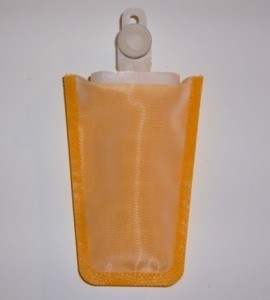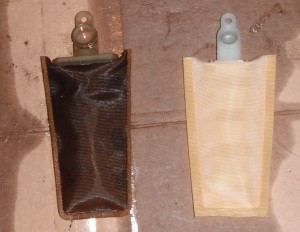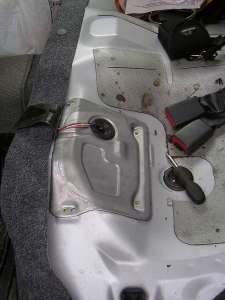
Coarse fuel filter
 The fuel filter in cars is a vital element of the fuel system that filters small particles of rust and dust, and also prevents them from entering the fuel system line. In the absence of a filter and with a small flow area in the fuel line, particles of dust and rust clog the system, preventing the supply of fuel to the engine.
The fuel filter in cars is a vital element of the fuel system that filters small particles of rust and dust, and also prevents them from entering the fuel system line. In the absence of a filter and with a small flow area in the fuel line, particles of dust and rust clog the system, preventing the supply of fuel to the engine.
The filter system is divided into two filtration stages. The main and first stage of fuel cleaning is coarse cleaning, which removes large particles of dirt from the fuel. The second stage of cleaning is fine fuel cleaning, this filter installed between the fuel tank and the engine allows you to remove small particles of dirt.
Types and categories of filters
Depending on the fuel system, a fine filter is selected for the reasons that each filter for each fuel system is different in design.
Therefore, we have three types of filters depending on the fuel supply system:
- Carburetor;
- Injection;
- Diesel.
Filters are also divided into two categories: main (they are located in the fuel line itself (as an example: a grid in the tank), as well as submersible - they are installed in the tank along with a pump.
The coarse fuel filter is a mesh filter, as well as a reflector, the mesh consists of brass and does not allow particles larger than 0,1 mm to enter. Thus, this filter removes large impurities from the fuel. And the filter element itself is located in a glass, which is attached with a small ring and a pair of bolts. Paronite gasket closes the gap between the glass and the body. And at the bottom of the glass is a special pacifier.
Thus, the filter cleans before gasoline enters the fuel system. Also, the fuel filter uses a valve for injection reduction, which regulates the working pressure in the fuel system, all this is installed in addition to the direct injection system. And excess fuel can be diverted back to the fuel tank. In the diesel system, the filter is functionally used in the same way, but it necessarily has a different design.
If the fuel filter is to be replaced by yourself, you first need to determine the location of the filter. By default it will be:
- Under the bottom of the car;
- In the fuel tank (mesh in the tank);
- Engine compartment.
The fuel filter can be easily changed without the help of professionals, but if you doubt your abilities, you can ask for advice from more experienced motorists or ask specialists. Also, experts point out that you need to change the fuel filter every 25000 km. But it also depends on the fuel that you use, if the fuel is of poor quality, then this action is recommended to be performed more often.
Filter Clogging Indicators
The main indicators that the filter is clogged:
- When driving uphill, it jerks you a lot;
- A sharp drop in engine power;
- The engine often stalls;
- Increased fuel consumption;
- Jerking car while driving.
Particularly economical drivers try to cheat and wash the filter with water and then install it back. This will not facilitate the process, since the dirt is absorbed into the fibers of the mesh and it is not easy to wash it off. But after such cleaning, the filter loses its throughput, which is even worse for the car.

This element requires confidence in quality, so we advise you to use only original parts, here are some of the original manufacturers of parts for Toyota: ACDelco, Motorcraft and Fram.
It is worth changing the filter only in the open air, fuel fumes are hazardous to health and can lead to fire, it is recommended to prepare a fire extinguisher before work. Do not smoke or light a fire near the machine. We advise you to disconnect the battery to avoid sparks. It is also recommended to monitor the pressure level in the system.
Filter replacement

Due to the fact that the filters are different in design, the algorithm for replacing them will be different. However, for the sake of example, a car was chosen - Toyota Yaris. First of all, we reduce the pressure in the system. To perform this action, we will remove the fuel pump fuse, which is located near the gear knob. This procedure has disabled the pump and now we can start the engine. After waiting 1-2 minutes, the engine will stall, which will be a clear sign of a drop in pressure in the fuel system. Now let's move on to the right wheel, where the filter itself is located. It is located on the right, near the fuel tank. Unfasten the pump by pressing the latches. Take out the old filter. Be careful when installing, the arrow on the filter must go in the direction of the fuel flow. We return the fuel fuse and, if necessary, “light up” the car. Due to an imbalance in the pressure in the fuel system, the car will not start the first time, you need to wait some time until the pressure in the system stabilizes.
Let's take note that there was no filter on older cars and the motorist had to connect it himself. The standard case is when this was done in the section of the suction line, directly in front of the fuel pump. It is worth taking into account the fact that there are modern models without a filter, as well as those equipped with injection do not have pumps. As an example, Ford Focus and Mondeo were without filters from the very start, and this unit was excluded from Renault Logan about five years ago. If desired, you can retrofit the system yourself, but in modern models this does not matter: it has been empirically proven that the grid wears out approximately simultaneously with the pump itself. In this embodiment, the assembly has to be completely changed, which in itself is an expensive pleasure, as well as quite complicated and painstaking, since the pump is usually located in an inconvenient place, and there is no technological hatch.
While there are models without a filter, models can also have a different filter arrangement. The filter can be remote; or go with a replaceable cartridge, which is located directly in the fuel pump. Easily removable tips are a connecting element of the fuel line. In order to remove them, you need to use round-nose pliers.

